Women of the fourth world
2017-2019
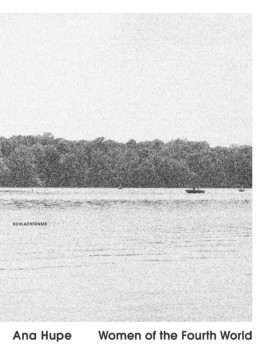
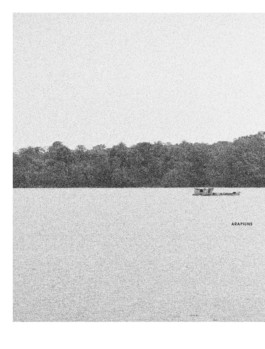
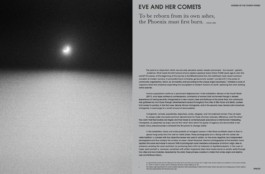
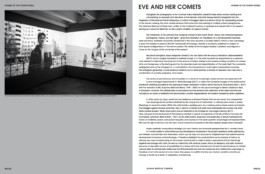
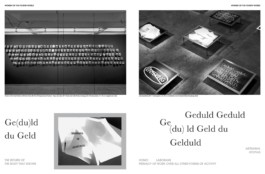


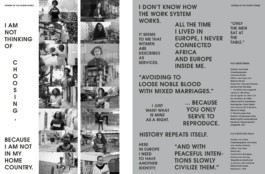
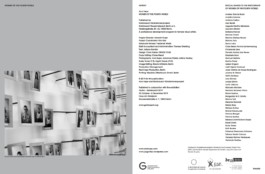
EVA, COMETS AND ALIENS
EVA AND HER COMETS
To be reborn from its own ashes, the Phoenix must first burn
- Octavia E. Butler
The past is an abyss from which we can only perceive certain wrecks and simple – but crucial – genetic evidence. What made the first humans (Homo sapiens sapiens) leave Africa 70,000 years ago to walk the world? Of course, at the beginning of this journey is the Mitochondrial Eve, the matrilineal most recent common ancestor of modern humans. In primordial forms of kinship, gynecocratic society1 carried with it the power of community organization, which, by its mobility, and according to the unique origin hypothesis2 , initiated a cycle of migratory flows that ended by expanding the occupation of modern humans on earth, replacing the other existing homo species. Human populations continue in permanent displacement. In the installation Women of the Fourth World (2017), Ana Hupe portrays a contemporary community of women that has formed through a shared experience of having recently immigrated to a new country. Real and fictitious at the same time, this community was gathered by Ana Hupe through advertisements spread throughout the cities of São Paulo and Berlin, posters that looked to portray, in the first case, female African immigrants, and in the second case, female Latin American immigrants, in exchange for a small amount of remuneration.
Immigrants, nomads, expatriates, deportees, exiles, refugees, and the enslaved women: They all seem to merge under one same common denominator for those who fear newness, difference, and ‘the other.’ The claim that their bodies are fragile and their future is contemptuously precarious is intentionally misleading. Immigrants, as presented by Hupe, are not this ‘other’ from which the power of agency and enunciation is dis- missed. Here, precariousness is reversed into the power to change reality.
In the installation, black and white portraits of immigrant women in Sao Paulo and Berlin seem to float in space hung away from the wall on metal plates. These photographs are in dialogue with the cartes-de- visite tradition: a camera with four objective lenses was used to obtain, on the same negative, four independent photographs and thus multiply the number of cards. Albert Henschel, German photographer of the Brazilian court, applied the same technique in around 1850 to photograph royal members and people of African origin, free or enslaved, evading the usual exoticism by portraying them with the willpower of dignified subjects.
In the case of Hupe, each portrait is, moreover, combined with written fragments taken from books found on erratic walks through the cities she has inhabited. Selected by the artist, these phrases construct a fable that unites origin and destiny, real and fictitious history.
Alongside the photographs, a two channel video installation presents these same women reading and commenting on excerpts from the diary of the German naturalist Georg Heinrich Langsdorff and the biography of Mahommah Gardo Baquaqua, a native of Zooggoo kept as a slave in Brazil. By juxtaposing scenes of the women reading, the work reveals tensions that come from the meeting of multiple cultural perspectives. The historical distance of these texts, written in the nineteenth century, is updated and played with in the present, serving as a place for reflection on the current condition of migrant women.
The materiality of the artworks that comprise Women of the Fourth World – black and white photographs, photograms, videos, and LED lights – gives the installation an impression of a lost temporality between past and future. Aesthetic and poetic tendencies in the work become a futuristic fable in which a new cosmology is read: the tradition is allied to the DIY homemade technology; identity is constantly redefined in relation to time-space configurations. In this techno-poetic, the reality of the immigrant bodies, therefore, reconfigures a future on the margins of the narratives of the present.
Recidivist immigrant, Hupe integrates herself in her own fable with the sound installation Lebensassistenz (2017) (which roughly translates as Assisted Living). In it, the artist recounts her experience as a personal care assistant in Germany. The body put at the service of others, added to the already existing condition of vulnera- bility and foreignness, is the starting point for the abandonment and objectification of the body itself. The constantly subjugated work of the immigrant is, in contradiction, the driving force in most highly industrialized countries. This ambiguity generates, in both personal relations and in state policies, a mixture of repulsion and care and a combination of curiosity, prejudice, and racism.
The tactics of permanence and circulation in a world of increasingly closed barriers are presented with humor and legal impertinence in White Marriage (2017), a video that combines images of the performative binational wedding recorded at the opening of Hupe’s exhibition in Berlin (which ironically took place April 1, 2017), with the narration of MC Xuparina (Marcela Maria, 1978 – 2016) on the use of marriage to obtain residence visas in European countries. The arbitrariness of procedures and the bureaucratic absurdity of the state machine are mocked by an action of solidarity that rehumanizes a society fragmented by the borders imposed by state capitalism.
In other works by Hupe, narrative is treated as individual threads that can be woven into unexpected new drawings for the patterns dictated by the unique line of colonialism. In Leituras para mover o centro (Readings to move the center, 2016), the artist builds a reading room as a meeting place where voices and stories that struggle against erasure emanate. Also in search of stories that resist and reverberate like echoes, the artist starts another project: Muito futuro para uma só memória (A lot of future for one single memory, 2017). Here, she goes to the backlands of Pernambuco (sertão) in search of fragments of the life of Maria Francisca da Conceição (unknown date of birth - 1961). As the artist enters, physically and poetically, a terrain that bears the marks of invisibility, racism, and social inequality, she touches on the harsh question of privilege and representation. Who has the right to tell his or her own story and to whom has the power to tell other people's stories been entrusted?
Hupe's aesthetic and political strategy is to hack history and formulate perspectives for a ‘counter future’ in a world hostile to autochthonous and afrodiasporic projections. The project questions white, patriarchal, and Western normativities and rationalism, which are the heirs of a Eurocentric Enlightenment that determined the development of science and technology. It therefore highlights the contradictions and omissions of history by offering new ways of elaborating on the present and the past in order to build a speculative fiction that brings together technology with myth, as well as collectivity with political power. Africa, its diaspora, and Latin America become an abundant source of possibilities for a future yet to be invented and not just the reminiscence of a failed colonial past. To symbolically rediscover the Mitochondrial Eve and her communal and matriarchal cosmology is, therefore, to sit in the comet of a non-linear time-space, to reaffirm the flow as a human condition and the ex- change of barter as a factor in adaptation and learning.
In a gynaecratic society only the offspring in the maternal line are taken into account. Cf. C. Knight, ‘Early human kinship was matrilineal,’ in Early Human Kinship, N. J. Allen, H. Callan, R. Dunbar and W. James eds., Blackwell, Oxford, 2008, pp. 61-82.
The unique origin hypothesis is the most accepted hypothesis within paleontology. It states that all human society descends from a single group of Homo sapiens who lived approximately 300 thousand years ago
JULIANA GONTIJO
Women of the Fourth World, 2017 - 2019
Published by
Goldrausch Künstlerinnenprojekt,
Goldrausch Frauennetzwerk Berlin e.V.,
Herzbergstraße 40 – 43, 10365 Berlin.
A professional development program for female visual artists.
Project Director: Hannah Kruse
Project Coordinator: Kira Dell
Graduate Trainee: Frederiek Weda
Staff Accountant and Administration: Theresa Strebling Text: Juliana Gontijo
Design: Clara Huber, FRENDZ.CLUB
Text: Juliana Gontijo, https://juligontijo.wordpress.com/
Copy Editing: Chloe Stead
Photography: Ana Hupe, Johannes Förster, Letícia Godoy, Suely Torres (P. 8), Ingrid Krauss (P.12)
Image Editing: Eberle & Eisfeld, Berlin
Production Management: Red Cape Production, Berlin
Printing: Medialis Offsetdruck GmbH, Berlin
© 2019 for this publication:
Ana Hupe and Goldrausch Künstlerinnenprojekt
SPECIAL THANKS TO THE PARTICIPANTS
OF WOMEN OF THE FOURTH WORLD:
Andrea Garcia Borja Andréia Salame Antônia Cattan
Aua Baldé
Augusta Martins Mbabala Azucena Moran
Barbara Marcel
Bernice Traoré
Bibicha Dieteso Nsuka
Bibicha Zolo
Bruna Lobo
Clara Berza Forcha Epnkemasong Chrislande Dely
Daniela Santos das Neves Elisabete Sanc
Gertuah Batistie
Gerths Pierre
Isabel Kingani
Iveth Mputu Emanuel
Joise Cristine de Souza Rodrigues
Juliana M. Streva
Kettia Badeau
Lina Gómes
Louise Edimo
Lucía Jxtacuy
Manuela Morales
Mariana Barbosa Pithon
Marie Desline
Margarida M.C. Simão
Marina Faé
Melanie Garland
Melisa Ross
Melissa Dullius
Michel Dieulourde
Patricia Rangel
Patricia Santos
Rebeca Dominiciano Souza Roseli Dutra
Suely Torres
Ruth Bourre
Patience Nwamaka Echeme
Tatiana Heide Calvozo
Vanessa Ramos-Velasquez Verlande Verdieu